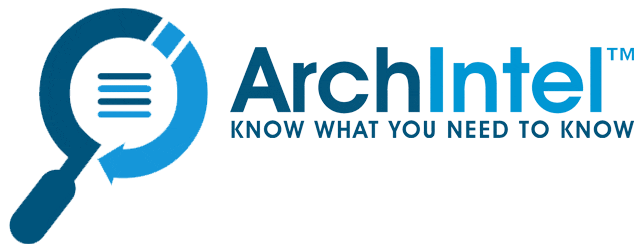Jeremy Ross, vice president of business development and proposals at Trace Systems recently spoke with ArchIntel regarding success, lessons, proposals and data collection and analysis within competitive intelligence as well as how understanding the trends and bidding thoughtfully can grow revenue and notoriety within the government contracting (GovCon) sector.
“The best practice when you’re starting out as a smaller company is to make sure that competitive intelligence informs your strategy, it doesn’t become your strategy. ”
ArchIntel: What are some of the lessons you’ve kind of learned within the field of competitive intelligence?
“I’ve seen the competitive intelligence process from a couple of different perspectives. The most significant lesson that I’ve learned is that not all CI is created equal. Based upon the number of resources you have as a company, you can make value tradeoffs on how you’re going to use competitive intelligence.
Larger organizations have their own shop dedicated to large amounts of data aggregation and put their findings into context to easily guide decision making. Here at Trace, we have to use our competitive intelligence specific to opportunities that we think that we can prime. That’s a completely different operation and mindset.
When you break our process down to use as few resources as possible, the main lesson is that there will always be a dark horse out there. You cannot account for that when you have limited resources to use. The best practice when you’re starting out as a smaller company is to make sure that CI informs your strategy, it doesn’t become your strategy.
Competitive intelligence should not be mistaken for total knowledge of your current competitive positioning. In any bid environment, 80 percent of the data is the best you can hope to find. You need to account for the other 20 percent, which could be full of unknowns or people you know.
As a mid-tier company, when you’re looking at your competition that is five-times your size and scale, there are two ways you can look at that situation. You can view it as an opportunity to be more nimble and be smart about where you attempt to gather data, or you can allow yourself to be overwhelmed and think, ‘I can’t compete in this space.’
I spend most of my time figuring out my competitors’ weaknesses and what our larger competitors are lacking. I vector my competitive intelligence on where they are not flexible. I also research exactly where they have resources positioned across the globe that could provide them with the information to out-influence us.”
ArchIntel: How do you personally measure success within competitive intelligence?
“In competitive intelligence, success is ultimately judged by your win rate. It should be one of the primary factors on your bid decisions. At Trace, we don’t fall into the vicious cycles of thinking we have to bid on everything in order to maintain rhythm in the market or utilize our business development and proposal staff appropriately.
We’ve taken the time to prepare for bigger opportunities and understand the preparation needed for that challenge. As long as the capture continues, the competitive intelligence continues and we refresh our artifacts and write our eventual draft proposals. That’s equally as successful to me as working hard to expand within a given market segment.
Also, successful competitive intelligence informs your ability to pick the right market segments and more importantly, adjacent market segments. You will win a lot more because you know your competition and your customers. You know your own strengths, weaknesses and differentiators will also help you win new work within those segments.
You have to do a capability-to-capability assessment. If you get down to the nuts and bolts, you can make an offering that’s truly unique and better than what larger competitors have to offer. We use competitive intelligence to find out why our competition can deliver offerings cheaper and see if it’s actually an innovative approach.
Competitive intelligence should reveal the companies that are on the bleeding edge of trends to differentiate themselves in a solution-driven draft procurement instead of entering a particular area and focusing on staff augmentation.”
ArchIntel: How is competitive intelligence within the government contracting (GovCon) sector unique?
“Competitive intelligence in government contracting is unique because so much information is publicly available. What differentiates the GovCon competitive intelligence is your ability to boil down your data and then how it’s applied to a specific agency or contract.
Understanding your bid environment is crucial to how I do business development and win work in competitive intelligence. Tactically speaking, that’s where intelligence is the most helpful. CI is beyond just knowing what federal agencies are doing; it’s also about what their contracting trends.
That type of data will help inform the way that we approach pricing, solutions, staffing and transition as well as understand their award trends based upon the best-value continuum. That is unique to the GovCon sector.
Within GovCon, we’re not trying to sell to a certain personality. We’re trying to sell to a bureaucracy that even if they don’t know, takes on a personality of itself, and reveals itself through competitive intelligence trend data.”
ArchIntel: How do you balance privacy and confidentiality of federal agencies when developing competitive intelligence?
“Competitive intelligence becomes table stakes. Everybody’s going to know the same amount of data because there’s a limited amount of information you need to know. But at the same time, you still have your competitive intelligence and spin it because if you actually don’t know the same things that your competition does, you’re fighting with one hand behind your back and you wouldn’t even know it.
You have big organizations and capture organizations that can break through that wall through previous relationships or creative contact-chaining analysis. That’s how you get additional data that can really help you earn an advantage.
Whereas on the outside of the government, there are no restrictions. However, you have to use your competitive intelligence to understand what federal agencies are trying to achieve and understand the end state objective from within the government itself.”
ArchIntel: How do you continue to improve and progress your competitive intelligence?
“We don’t learn what the winning bid is until you lose yours. We receive a significant amount of additional information, which could be construed as competitor intel when we lose. However, there are things we never find out.
Half the time, you can find out where your competition scored ratings, wise on your technical and management proposal, but you never find out the price from other competitors. You only know what your final tap was and what the winning price was. When you lose, you find out where you stacked up technically and management-wise to the eventual winner.
You almost always get a price analysis as well as what your total evaluated price was versus theirs. Contracting officers will also release that data on all of the losers, to each of the losers.
When we enter into any bid, we should always assume that the competition can score blue. If we lose, we complete an after-action and start peeling back the onion to see we didn’t really lose on price, but we lost because we didn’t score tactically as well as they did.
You can see that in some specific comments that were made in our debrief. We took those comments from our debrief, went back to our proposal, corrected everything that was there and created a process on how we were going to stack up in the future.
After that, we apply our improvements to how we approached our technical solution and pricing for the next contract. We knew what we had to fix, and, most importantly, how the government would evaluate some aspects that were left gray in the proposal. We’re able to apply that to our next submission.
Without that data, we wouldn’t have made some of the changes that we did. That’s the best case scenario where you have trends. It actually shows you something usable in your decision making.”

